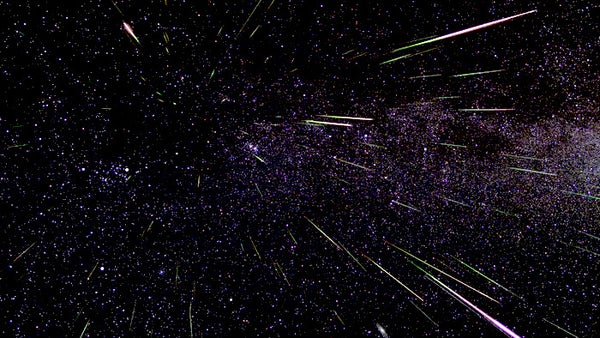This article was published in Scientific American’s former blog network and reflects the views of the author, not necessarily those of Scientific American
Most of us are used to the idea of seasonal, regular meteor showers. These celestial firework displays are typically due to the Earth's passage through a debris stream - an orbiting train of cosmic junk left behind by disintegrating cometary nuclei.
Famous showers like the Perseids or Leonids can be linked to the comets Swift-Tuttle and Temple-Tuttle, while a shower like the Orionids has its origins in the filth spewed by Halley's Comet during its 75 year orbit of the Sun.
But Earth is also pelted by material that's come from the collisional debris of asteroids and even from the ejected material from minor planets like Vesta, orbiting out beyond Mars.
On supporting science journalism
If you're enjoying this article, consider supporting our award-winning journalism by subscribing. By purchasing a subscription you are helping to ensure the future of impactful stories about the discoveries and ideas shaping our world today.
Today, about 87% of rocky meteorites that end up being found on Earth's surface belong to a pair of classes known as H and L type ordinary chondrites. This poses a puzzle, because the objects in the main asteroid belt that would be the likeliest suspects to produce rocky meteorites actually have a somewhat different mineral composition. The simplest hypothesis for explaining this is that the vast majority of rocky material hitting us comes from recent (in cosmic terms) asteroid collisions that, by chance, have supplied the H and L chondrite rocks.
In other words, most of the rocky meteorites we've been used to during human history could be a bit of a glitch, the result of a specific set of asteroid breakups - coming from perhaps no more than three particular parent bodies. Those collisions are thought to have all occurred within the past 466 million years.
Now, in a work published in Nature Astronomy, Heck et al. have literally dug up (or perhaps chipped off) evidence that supports this picture; indicating that a quite different mix of meteorites used to fall to Earth.
Limestone beds of an ancient seafloor, exposed in a Russian valley, contain micrometeorites that were embedded in marine sediments slightly before 466 million years ago. By measuring the detailed composition of 32 ancient meteorite fragments the researchers are able to demonstrate that these rocks represent a distinctly different set compared to what drops to the planet today. In fact, what are rare meteorite types now were very common hundreds of millions of years ago.
This means that we now have good evidence that over the history of the solar system the rocky material pelting the inner planets has indeed come from a range of different parent bodies. Dribbling in like a long, drawn out avalanche following specific collision and breakup events. Not only that, but we can rummage around in Earth's rock record and help build a picture of the deep, deep dynamical history of other objects in our solar system.
Think of that the next time you wish upon a falling star.
